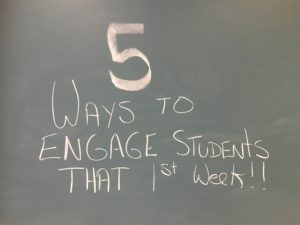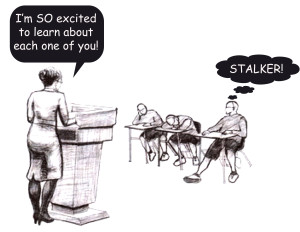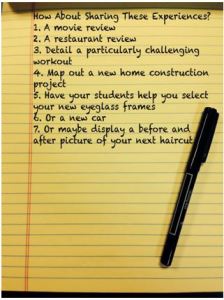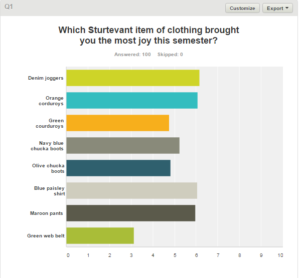My first week of school is right around the corner. It’s hard to give up summer. I love teaching, but work is work! It’s awfully cool to wake up and not have to perform a lesson plan. It’s wonderful to have your day magically unfold absent of a bell schedule. But hey…we’re teachers and pretty soon it’ll be showtime! I’m going to motivate you to grab your students by the virtual lapels and engage them in that crucial first week of the semester.
Today, my daughter-in-law and I were discussing TV shows. A while back, I encouraged her to watch a Netflix series called “House of Cards”. This afternoon, when I asked Niki if she’d watched, she responded, “I watched the first episode and it was slow. I’m sorry! I gave up on it.” I thought WOW…what an important message for educators. I feel confident that if my daughter-in-law gave “House of Cards” more time, she’d be hooked. But as far as Niki was concerned, the series’ window of opportunity had closed.
Comparing your class to a television series, I’ll admit, is problematic. But nonetheless, my comparison should inspire you to think about the crucial nature of engaging students right out of the chutes…that first week. Your kids could be like my daughter-in-law. When confronted with a plodding first episode, she chose to change the channel. Or, you could leave students on the edge of their seats…chomping at the bit…anticipating the next day’s lesson!
Research points to the crucial nature of student engagement. Put simply, when kids are engaged, they learn. Throughout my 31 year career in public education, my driving mantra when I craft a lesson…and I’ve produced thousands of them, is and has always been...Will this lesson engage students? The objective of this post is to share 5 tactics that will enthrall your students that pivotal first week. Included in each tactic, are links to the Hacking Engagement Podcast where these ideas are explored in further depth. If you like what you read…you’ll love what you hear!
1. Become More Approachable
John Hattie in his landmark 2007 book Visible Learning promoted the idea that student-teacher relationships are essential to the learning process. When students feel a bond with their teachers, they’re engaged and they learn! But forging these bonds is tricky. Often teachers, very understandably, come on too strong in that first week:
Instead of repelling your students by interrogating them or stalking them, why not practice some reverse engineering? Let them first get to know you first. Become more approachable by sharing some trivial and harmless aspects of your daily existence:
By sharing these experiences, you’ll become:
- Approachable
- Intriguing
- Familiar
- Safe
- Non-threatening
Once you become approachable, kids will gravitate to you. Then, you can start learning about them! To hear more about becoming more approachable, listen to Episode 4 of the Hacking Engagement Podcast:
2. Produce a Class Trailer
A few years ago, I went to the movies with my wife. Before the main feature, we watched some fascinating trailers for upcoming shows. After one engaging preview, my wife and I rotated toward one another and said, “Let’s come and see that when it debuts!” As soon as I turned back to face the screen, I immediately thought, I need to do a trailer for my class! I did! So should you!
Students are totally down with trailers. They watch them all the time on YouTube. Why not build significant anticipation for what your class holds in store? Here’s the trailer for my World Civilization class:
3. Challenge Kids to Improv your Classroom Procedures
Most teachers miss an amazing engagement opportunity the first week of school. They become obsessed with laying down the law! Their objective is to set the tone early by behaving like Marine Corps drill instructors barking out rules and classroom policies. Sadly, kids go through a lot of such induction experiences that first week. But…how about a fresh approach that’ll engage your students AND enlighten them about important class procedures simultaneously? Interested? I thought so!
Sadly, kids go through a lot of such induction experiences that first week. But…how about a fresh approach that’ll engage your students AND enlighten them about important class procedures simultaneously? Interested? I thought so!
Instead of assuming the position at the pulpit and sermonizing students about life in Room 111, why not empower kids to teach one another about classroom procedures?
I have 5 class procedure categories:
- Attendance
- Digital Citizenship
- Classroom Citizenship
- Assessment
- Effort
I prompt students to elect 5 ultra-dramatic students who will act as group captains. I then disperse the remainder of the students randomly. Once I have 5 groups, I assign them a classroom procedures category. I provide each group with specific examples of success in their assigned category. I give them 60 seconds to prepare an improv where they depict the procedure and explain why it’s important. It’s an intense minute!
Classroom Procedure Improvs have transformed a tedious week 1 task into a hilarious day of cheesy performances full of slacker rule breakers and stern authority figures! In the process, kids learn and embrace classroom procedures. Sometimes, performances can inspire fascinating dialogue in which I just may be persuaded to make procedural adjustments! How interesting!
To learn more about Class Procedures Improvs, please listen to Episode 1 of the Hacking Engagement Podcast:
4. Present Like a Zen Master
It’s hard to keep kids attention during presentations. They’re used to hilarious videos, action-packed games, and Twitter feuds between celebrities. Hence, your presentation about the Hindu Caste System, or how to cite in MLA format, doesn’t carry the same pop! I consider myself an engaging storyteller, but I struggled with this too.
That all changed last summer thanks to an amazing book suggestion. Presentation Zen by Garr Reynolds transformed the way I teach! Before I read this book, unknowingly while presenting…I had the audacity to ask my audience to multi-task! I projected slides filled with bullet points and text. I was unintentionally requiring my audience to read my bullets, while simultaneously listening to my awesome stories! What was I thinking? I guess, I was presenting to my students the way my former teachers used to present to me. There’s a much better way:
DO
- Include 1 compelling image on each slide.
- Limit text to a word, title, or phrase.
- Enchant the audience with stories your wonderful image inspire.
- Provide a physical leave-behind at the end of the presentation which contains your treasured bullet points.
DON’T
- Litter your slides with bullet points and text.
- Include distracting animations or ostentatious transitions.
- TURN YOUR BACK TO YOUR AUDIENCE AND READ THE TEXT IN YOUR OWN SLIDE.
Here’s a Presentation Zen-inspired presentation from my history class. Each slide is dominated by a compelling image and text is at a minimum:
In many ways, this book spoiled me. I have zero tolerance for poor presentations. I recently went to a PD session and the first presenter put up a Word document on the screen! SAY WHAT!?! The second presenter turned their back to us and read their own bullet points!
Create then perform a Presentation Zen-inspired presentation that 1st week. To learn more about engaging presentations, please listen to Episode 10 of the Hacking Engagement Podcast:
5.Take Student Preference Pulse with SurveyMonkey
One of life’s great challenges is to determine what someone else is thinking. Understanding what your kids are thinking is essential in terms of engagement. You can’t engage them if you don’t know their preferences. SurveyMonkey is an awesome free tech tool which will allow you to do just that!
Typically, if you ask for student opinion, you’ll get a lot of feedback from class extroverts. But these kids don’t speak for everyone. SurveyMonkey is a cool way to capture all student sentiment because it can be done anonymously, which ensures great authenticity. Here are 4 ways you could use SurveyMoney in the first week to engage students:
- Use it to bond. Poll students on personal preferences. What’s your favorite movie? What’s your favorite song? Or, kids could help you make a tough decision. What restaurant should I take my significant other to on our next date? Check out this ridiculous SurveyMonkey I did with my kids last year:
- You could employ SurveyMonkey to empower students to select from self-directed learning options.
- You could utilize SurveyMonkey as a bell-ringer. Ask a thought-provoking question, or present students with a host of controversial statements and ask them to embrace and defend one!
- And finally, conduct a class election. They could reward a classmate’s project 1st Prize, or select the Room 111 Citizen of the Week.
To learn more about SurveyMonkey, please listen to Episode 8 of the Hacking Engagement Podcast:
Please check out all of the episodes of the Hacking Engagement Podcast on iTunes! My book 50 Tips & Tools To Engage Teachers and Learners Daily will be available in the early autumn of 2016.





